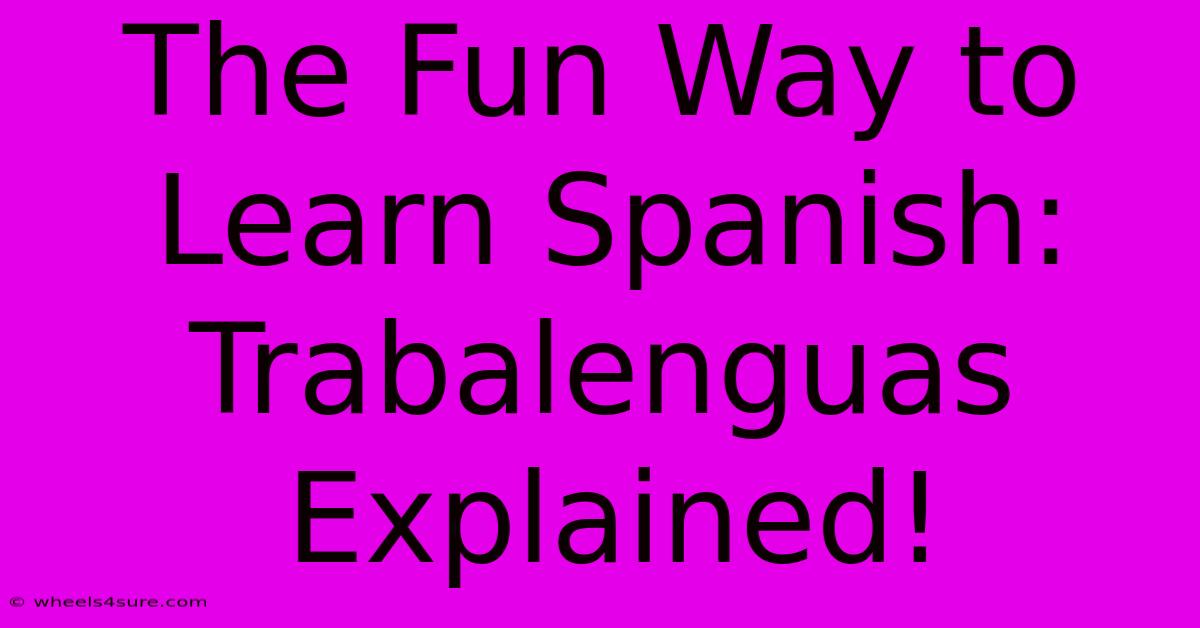The Fun Way To Learn Spanish: Trabalenguas Explained!

Table of Contents
The Fun Way to Learn Spanish: Trabalenguas Explained!
Learning a new language can sometimes feel like a slog, filled with endless vocabulary lists and complex grammar rules. But what if learning Spanish could be…fun? Enter the trabalenguas, or tongue twisters! These playful phrases are a surprisingly effective way to improve your pronunciation, expand your vocabulary, and boost your overall fluency. This article will delve into the world of Spanish tongue twisters, explaining why they're so beneficial and providing you with some examples to get you started.
Why Use Trabalenguas to Learn Spanish?
Trabalenguas offer a unique approach to language learning because they focus on the mechanics of the language. Unlike rote memorization, tongue twisters engage you actively:
-
Pronunciation Perfection: Repeating trabalenguas helps you practice tricky sounds and improve your articulation. Spanish has many sounds not found in English, and these tongue twisters provide targeted practice.
-
Vocabulary Enrichment: Many trabalenguas incorporate common words and phrases, subtly expanding your vocabulary in a memorable way. You'll learn words organically, associating them with the fun of the twister.
-
Improved Fluency: The repetitive nature of tongue twisters helps you build muscle memory, leading to smoother and more confident speech. The more you practice, the more natural your Spanish will sound.
-
Enhanced Listening Skills: Listening to native speakers recite trabalenguas can help you identify subtle pronunciation nuances and improve your comprehension.
-
Increased Confidence: Mastering a trabalenguas provides a small sense of accomplishment, boosting your motivation and confidence in your language learning journey.
Examples of Hilarious Spanish Tongue Twisters (Trabalenguas)
Here are a few trabalenguas to get your tongue twisting:
Easy:
-
"Pablito clavó un clavito; un clavito clavó Pablito." (Pablito hammered a little nail; a little nail hammered Pablito.) This focuses on the "cla" sound.
-
"El perro de San Roque no tiene rabo." (The dog of San Roque doesn't have a tail.) This one's good for practicing the "r" sounds.
Medium:
-
"Tres tristes tigres, tragaban trigo en un trigal." (Three sad tigers were eating wheat in a wheat field.) A classic that works on the "tr" sound.
-
"Para hacer arroz con leche, hay que tener leche, para hacer leche, hay que tener vaca." (To make rice pudding, you need milk, to make milk, you need a cow). This one is longer and challenges sentence flow.
Hard:
-
"Erre con erre, guitarra; erre con erre, barril; rápido corren los carros, rápido corren los carritos." (R with r, guitar; r with r, barrel; fast run the cars, fast run the little cars.) A true test of your "r" skills!
-
"Dime, si sabes, si sabes dime, que es mejor, la vida o la muerte?." (Tell me, if you know, if you know tell me, what is better, life or death?). This is a bit harder due to sentence structure.
Tips for Mastering Trabalenguas
-
Start Slowly: Begin with easier trabalenguas and gradually increase the difficulty.
-
Listen Carefully: Listen to a native speaker pronounce the trabalenguas several times before attempting to say it yourself.
-
Break It Down: Divide the trabalenguas into smaller phrases or words, focusing on one section at a time.
-
Practice Regularly: Consistent practice is key to mastering these tongue twisters. Aim for a few minutes of practice each day.
-
Record Yourself: Recording your pronunciation allows you to identify areas that need improvement.
-
Have Fun! The most important thing is to enjoy the process! Learning a language should be enjoyable.
Incorporate Trabalenguas into Your Learning
Don't just limit yourself to these examples! Search online for more trabalenguas – you'll find countless variations to keep you entertained and engaged while improving your Spanish skills. Using trabalenguas as part of a comprehensive language learning plan will make your journey more fun and ultimately more successful. So, get your tongue ready and start twisting! ¡Buena suerte! (Good luck!)

Thank you for visiting our website wich cover about The Fun Way To Learn Spanish: Trabalenguas Explained!. We hope the information provided has been useful to you. Feel free to contact us if you have any questions or need further assistance. See you next time and dont miss to bookmark.
Featured Posts
-
Christian Horners Net Worth The Road To Riches
Apr 02, 2025
-
Lewis Hamiltons Net Worth A Legacy In The Making
Apr 02, 2025
-
Zahide Tik Tok Debunking Ageist Myths
Apr 02, 2025
-
Bugoy Carino Beyond The Years A Star Still Shining
Apr 02, 2025
-
Michael Polanskys Age A Deep Dive Into His Life
Apr 02, 2025
